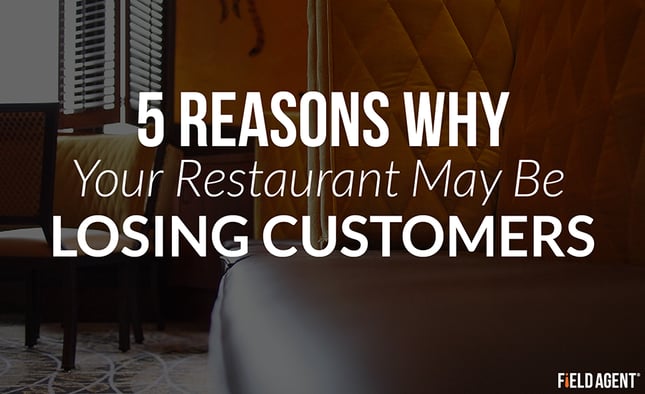
5 Reasons Why Your Restaurant May Be Losing Customers

Loyal customers are hard-won, especially in the restaurant business.
With 60% of restaurants closing or changing ownership during their first three years (source: Bloomberg Businessweek), restaurants must capitalize on each and every guest who walks through the door. However, as the recent high profile struggles of several “established” national chains suggest, restaurants, regardless of reputation or life cycle stage, shouldn't take a single patron for granted.
Below I address 5 reasons why your restaurant could be losing customers:
1. Neglecting the fundamentals of food quality, price, etc.
“It isn’t rocket science,” concluded Deloitte, following a survey of 4,000 restaurant customers. “A few things matter to most everyone.” These things, the report added, include price, taste, and staff attitude.
We also conducted our own in-house research on the matter, asking 180 restaurant patrons to rank seven different restaurant attributes by importance. No surprises: the fundamentals of taste/food quality and price/value were at the top.
The first and most important safeguard against losing customers? Attention to fundamentals. [My high school basketball coach would be proud.]
2. Poor housekeeping
After studying 373 separate service failures reported by restaurant customers, researchers Beth Chung and K.D. Hoffman concluded that, in restaurants as well as life, cleanliness is next to godliness.
They wrote, “Facility problems such as cleanliness were the most severely rated mistakes, were remembered longest by customers, and were associated with the lowest customer-retention rates” [emphasis added].
Chung and Hoffman warned restaurants against, for instance, bad smells and unsanitary conditions.
3. Menu lacks healthy options
Deloitte’s research pinpointed nutrition, e.g., healthy menu items, as a real opportunity for improvement, especially for restaurants in the casual dining segment. Customers were asked to rank their satisfaction with 23 different restaurant factors—from food taste to service speed—at their most-frequented restaurant. At 19, “nutritious food” registered toward the bottom of this satisfaction ranking, perhaps signaling an opportunity to win and retain customers.
4. Underestimating the impact of negative word-of-mouth
According to Chung and Hoffman, negative word-of-mouth is one major reason restaurants should be immensely concerned with service failures. Dissatisfied customers tend to talk—and then some.
Consequently, managers should intervene in areas that sit particularly bad with guests, areas such as out-of-stocks and seating problems. Moreover, restaurant managers should try to preempt negative word-of-mouth by addressing service failures quickly and to the satisfaction of patrons.
5. Not understanding what truly generates repeat visits for your restaurant
Because loyal customers are precious to restaurants, it’s essential to have a firm grasp on the factors most responsible for bringing customers back again…and again…and again. Deloitte’s report identified “practical” considerations such as food taste, location, and value as critical determinants of repeat business.
However, such factors could potentially fluctuate from restaurant to restaurant—making it necessary for restaurateurs to do the painstaking but necessary work of identifying what matters most to their guests, to keep them coming back for more.
Retail Solutions for Any Challenge
The QuickShop Solution
Restaurants have traditionally relied on mystery shopping to better understand the quality of their food and operations from the customer’s point-of-view. After all, according to Chung and Hoffman, "At the core of good [restaurant] service are good data—an understanding of what customers want and the extent to which a restaurant is meeting expectations."
Compared to conventional mystery shopping, QuickShops offer a simpler, faster, more affordable means for assessing restaurant operations and customer attitudes. To learn about QuickShops and how they help restaurants circumvent the problems above, download the report, “The QuickShop: How Restaurants Use Their Own Customers to Co-Create Outstanding Dining Experiences.”
See Also: Free Case Study Download: Mystery Shopping results from a local coffee shop
Mobile Research, Mystery Shopping, Restaurants, Customer Experience


